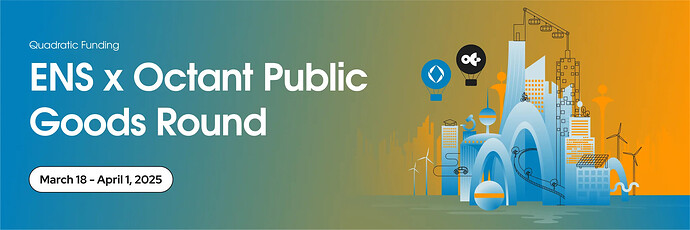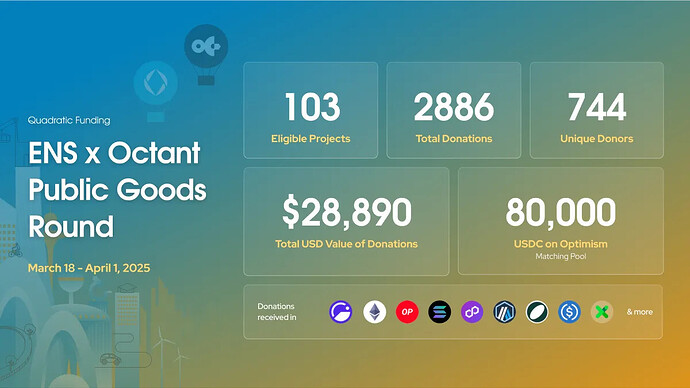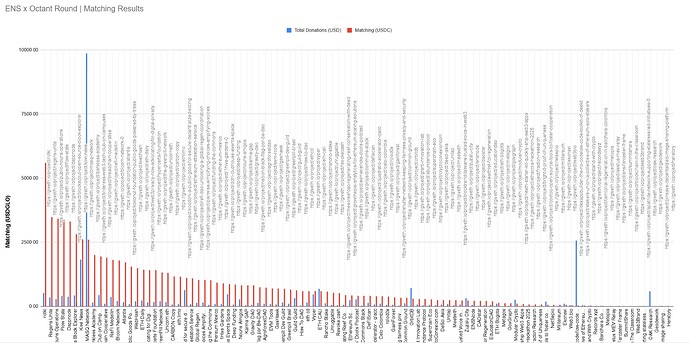ENS x Octant Public Goods Round Results & Wrap-up (March 18 — April 1, 2025)
GM builders, dreamers, and public goods supporters!
The ENS x Octant Public Goods Quadratic Funding Round has come to a close—and the results are in!
This round was all about supporting web3 infrastructure, education, and utility projects through a QF round powered by two of the most impactful names in the public goods space: ENS DAO and Octant.
Big thanks to ENS and Octant for seeding the round with 80,000 USDC on Optimism and showing up with enthusiasm, support, and serious impact.
 The Numbers
The Numbers
Matching pool size: 80,000 USDC on Optimism
Round Duration: March 18 — April 1, 2025
Max matching per project: 7% of the matching pool or 5600 USDC
Eligible Projects: 103
Total Donations: 2886
Unique Donors: 744
Total USD Value of Donations: $28,890
Tokens Donated: USDGLO, CELO, USDC, USDT, ETH, GIV, OP, ARB, MATIC, XDAI, SOL & more!
Eligible donation Networks: All Giveth supported networks – Arbitrum One, Base, Gnosis, OP Mainnet, Ethereum Mainnet, Polygon PoS, Polygon zkEVM, Ethereum Classic, Celo, Stellar, Solana.
The final results including all projects, amounts raised, and matching funds can be found here:
ENS x Octant PGs Round Final Matching Results
Important: Project owners – PLEASE double-check your Optimism recipient address!
Projects Eligibility
To make sure this round spotlighted genuine builders, projects had to:
![]() Be listed and verified on Giveth
Be listed and verified on Giveth
![]() Fit one or more categories: Infrastructure, Utility, Education
Fit one or more categories: Infrastructure, Utility, Education
![]() Complete application and verification before round start
Complete application and verification before round start
![]() Be selected by a curation team from Octant and ENS DAO
Be selected by a curation team from Octant and ENS DAO
Donor Eligibility & Sybil Resistance
The following mechanisms were used to ensure matching funds were allocated fairly according to genuine community support:
- Human Passport
- Using Passport’s Model Based API, each donor address was assigned a score based on on-chain activity. A score of 50 or higher was considered a pass for QF eligibility.- Addresses who did not achieve a passing score through the API could verify their uniqueness using stamps. ****
A Passport (stamps) score of 15 or higher also qualified the donor as QF-eligible.
- COCM
This round again used the Cluster-Optimized Community Matching (COCM) algorithm to calculate final matching. COCM rewards donor diversity and penalizes tightly clustered or coordinated donation patterns.
That means:
- Projects supported by donors who gave to a broad range of projects received higher matching
- Projects that had donations mostly from overlapping or highly clustered wallets saw reduced matching
Learn more about COCM here:
Matching Fund Distribution Chart:
Here’s the final breakdown of how the 80,000 USDC matching pool was distributed! Check out how all the projects got ranked based on the received matching!
Top Projects by Matching Allocation
Here are the top 10 projects in the ENS x Octant Public Goods Round, ranked by matching funds received:
Matching: 5600.00 USDC
Match per unique donor: 130.23 USDC
Matching: 3481.34 USDC
Match per unique donor: 128.94 USDC
Matching: 3420.29 USDC
Match per unique donor: 51.05 USDC
Matching: 3384.32 USDC
Match per unique donor: 99.54 USDC
Matching: 3313.72 USDC
Match per unique donor: 77.06 USDC
![]() Blockscout Open-Source Block Explorer
Blockscout Open-Source Block Explorer
Matching: 2812.64 USDC
Match per unique donor: 35.60 USDC
Matching: 2613.16 USDC
Match per unique donor: 67.00 USDC
Matching: 2596.34 USDC
Match per unique donor: 118.02 USDC
Matching: 2002.35 USDC
Match per unique donor: 74.16 USDC
![]() B<>rder/ess web3 Tech Club on Campuses
B<>rder/ess web3 Tech Club on Campuses
Matching: 1944.44 USDC
Match per unique donor: 60.76 USDC
’Match per unique donor’ is the matching divided by the total number of unique addresses that donated to the project.
The ‘Match per unique donor’ metric is interesting since COCM rewards donors who support a diverse set of projects. This means that projects that have a higher “match per unique donor” had a broader donor base.
 What’s Next?
What’s Next?
Forum post will be open for 3 business days for feedback and questions
Then we’ll ratify the results on Snapshot
Matching funds will be distributed soon after
Project teams: make sure your Optimism addresses are correct!
 Huge Thanks to You All
Huge Thanks to You All
To everyone who donated, built, shared, or supported — you’re helping shape the future of public goods funding.
More rounds are coming, and your support helps grow a sustainable ecosystem for web3 builders everywhere.
Let’s keep building. Let’s keep funding. Let’s keep the momentum going.
Have a question? Tag @yegor and drop a comment below ![]()
Got a feedback to share? Fill in this form and let us know about your experience
Updates:
- The Matching Funds have been distributed on April 23rd. Here you can find the transaction:
https://optimistic.etherscan.io/tx/0xf4445db5f59ce16fd1796860da6c3ba870015e5870f48d43c353eeed3eb846bf




